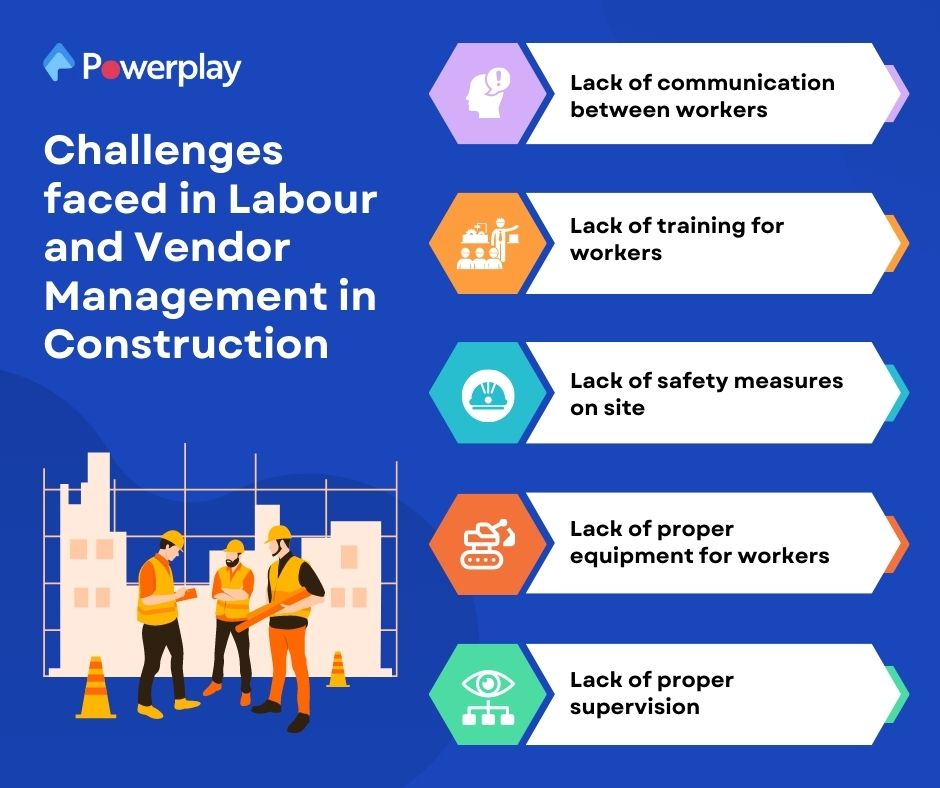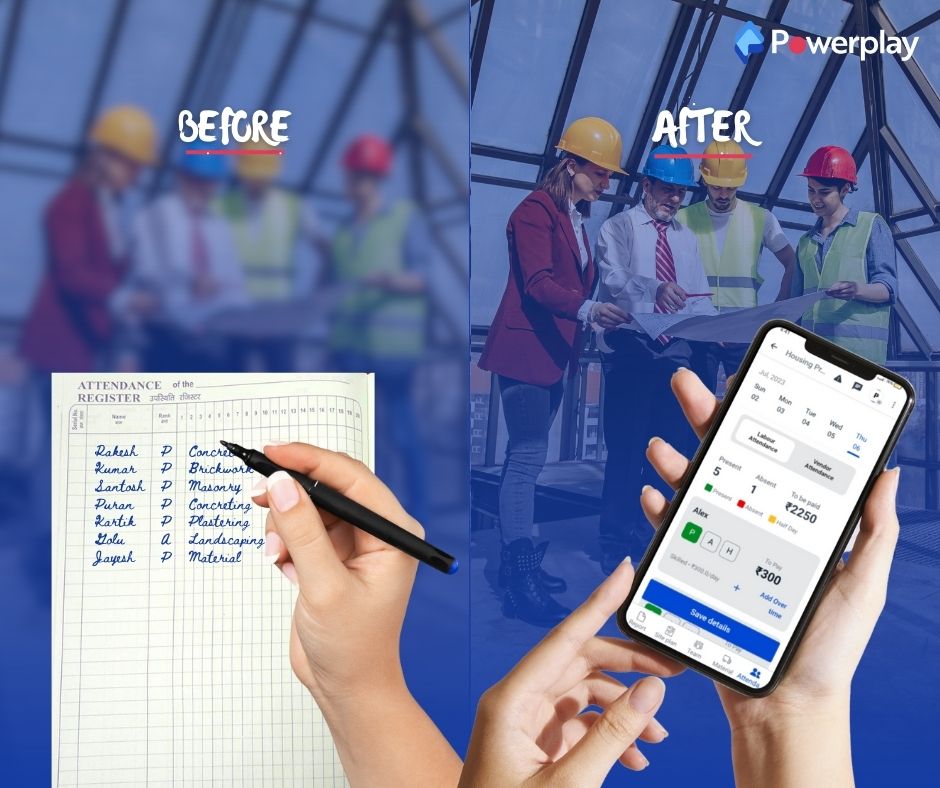Construction’s Unheralded Heroes: Managing the Chaos with Digital Tools
-
Kumar Abhishek Anand
- October 12, 2023

Table of Contents
ToggleLabour and vendor management in Construction
The labourers and vendors in the construction industry are like the humble cooks and decorators at a grand Indian wedding – they might not be in the spotlight, but without them, there would be no feast, no grandeur.
However, they are often managed like a ‘Jugaad’ band at the wedding, given last-minute instructions, no rehearsal, just expected to miraculously align with the chaotic preparations. The outcome? A comedy of errors – confused cooks, misplaced decorations, and ultimately a disappointed audience.
Just like a poorly coordinated wedding can lead to unhappy guests and overshooting of the budget, mismanagement of these key resources in construction leads to significant financial losses and time overruns for project owners.
So, isn’t it time we gave our labourers and vendors the right guidance, training, and management they deserve, enabling them to hit the perfect century every time?
Labour and Vendor Management – At a glance

Labour and vendor management in construction is the backbone process of a project. It involves organising and supervising two main parts of the workforce: the labourers who physically build the project, and the vendors who provide the necessary materials and services.
The process needs proper coordination between procurement officers, project managers, and site supervisors. Procurement officers are responsible for sourcing and purchasing materials from vendors. Project managers plan and allocate tasks, while site supervisors ensure that the labourers perform these tasks efficiently and effectively.
This management is crucial for the smooth running of any construction project as the labourers and vendors form the core workforce, turning blueprints into tangible structures. If they aren’t managed properly, the entire project can come to a grinding halt, leading to costly delays and poor-quality work.
In a nutshell, effective labour and vendor management ensures that a project is completed on time, within budget, and meets the required standards of quality.
Challenges in labour and vendor management
The challenges of labour and vendor management in construction are numerous and multifaceted.

Here are some of the challenges faced in labour and vendor management in construction:
1. Lack of communication between workers
Workers need to be able to communicate with each other effectively to ensure that the project is completed on time and within budget. However, communication can be difficult when there are language barriers or when workers are not trained to communicate effectively.
2. Lack of training for workers
Workers need to be trained properly to ensure that they can perform their jobs safely and efficiently. However, many construction companies do not provide adequate training for their workers.
3. Lack of safety measures on site
Safety is a major concern in the construction industry. Workers are often exposed to hazardous materials and dangerous equipment, which can lead to serious injuries or even death. However, many construction sites do not have adequate safety measures in place.
4. Lack of proper equipment for workers
Workers need to have access to the proper equipment to perform their jobs effectively and safely. However, many construction companies do not provide their workers with the necessary equipment.
5. Lack of proper supervision
Workers need to be supervised properly to ensure that they are performing their jobs correctly and safely. However, many construction companies do not provide adequate supervision for their workers.
These challenges can lead to poor performance, low productivity, and even accidents on site.
Excel Sheets: A Step Forward, Yet Not Enough

Once upon a time, Excel sheets were like the new heroes of the construction world. They helped to bring a bit of order to a messy pile of papers. Instead of having to search through stacks of paper forms, managers could now find what they needed on their computers.
But as construction projects started to become bigger and more complicated, these Excel sheets began to fall short. Think of it like trying to clean up a big, messy room with only a small broom. Sure, it helps a bit, but you’re going to need more tools to get the job done well and on time.
Doing maths in Excel can also get quite tricky when the numbers and formulas get complicated. And because we all make mistakes, sometimes wrong numbers get entered. These small mistakes can turn into big problems because one wrong number can mess up many calculations.
In short, while Excel sheets were a step in the right direction, they’re not enough to handle the large, complex tasks of today’s construction world.
Harnessing the Power of Digital Tools
In the old days, all of the labour & vendor management work was done using a lot of paperwork. Labour attendance was often tracked using sign-in sheets, and vendor bills were kept in physical folders. Think of it like trying to keep track of all the passengers at a railway station with just a pen and a notebook. There were many chances for mistakes, and it was not an efficient way to work.

But then, the digital age arrived, much like a new, fast train pulling into the station. This new ‘digital train’ has brought along a lot of changes. This new way of doing things is a big step forward and promises to bring about a lot of positive changes.
Fast forward to the present day, and things have changed dramatically. It’s like we’ve gone from travelling in bullock carts to zooming around in high-speed cars. Now, we have construction management apps that can track and record labour attendance, vendor bills, wages, and more at the click of a button. It’s a much more efficient and accurate system, making life easier for everyone involved in the construction project.
Concluding with a Chuckle

In conclusion, just as you wouldn’t run a marathon wearing flip-flops, managing labour and vendors in construction without the right tools can lead to costly missteps. By leveraging construction management apps, the once chaotic process of handling labour attendance, vendor bills, and wages becomes a seamless, efficient, and accurate affair.
Think of it like investing in a good pair of running shoes for a marathon. The initial cost may seem significant, but the comfort, speed, and endurance they provide translate into an overall better performance. Similarly, investing in construction management app subscriptions might seem like an additional expense, but consider this – they can help save more than 7% on overall construction costs. That’s like finding a hidden treasure chest in your backyard!
So, to all the business owners out there – it’s time to lace up those running shoes and sprint towards the finish line of project completion with ease, speed, and accuracy.
Share
Kumar is a digital content professional with more than 2 years of experience in Blog writing, copywriting and scripting. His passion lies in the art of creating convincing content that plays a major role in converting leads for SAAS businesses.












